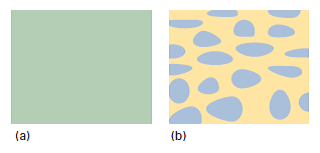Chapter 4. PHYSICAL TRANSFORMATIONS OF PURE SUBSTANCES
Introduction
Vaporization, melting (fusion), and the conversion of graphite to diamond are all examples of changes of phase without change of chemical composition. The discussion of the phase transitions of pure substances is among the simplest applications of thermodynamics to chemistry, and is guided by the principle that the tendency of systems at constant temperature and pressure is to minimize their Gibbs energy.
4A Phase diagrams of pure substances
First, we see that one type of phase diagram is a map of the pressures and temperatures at which each phase of a substance is the most stable. The thermodynamic criterion of phase stability enables us to deduce a very general result, the ‘phase rule’, which summarizes the constraints on the equilibria between phases. In preparation for later chapters, we express the rule in a general way that can be applied to systems of more than one component. Then, we describe the interpretation of empirically determined phase diagrams for a selection of substances.
4B Thermodynamic aspects of phase transitions

We then consider the factors that determine the positions and shapes of the boundaries between the regions on a phase diagram. The practical importance of the expressions we derive is that they show how the vapour pressure of a substance varies with temperature and how the melting point varies with pressure. Transitions between phases are classified by noting how various thermodynamic functions change when the transition occurs. This chapter also introduces the ‘chemical potential’, a property that will be at the centre of our discussions of mixtures and chemical reactions.
Impact
The properties of carbon dioxide in its supercritical fluid phase can form the basis for novel and useful chemical separation methods. See the Impact at the end of the chapter for a discussion of this topic.
4A: PHASE DIAGRAMS OF PURE SUBSTANCES
Why do you need to know this material?
Phase diagrams summarize the behaviour of substances under different conditions. In metallurgy, the ability to control the microstructure resulting from phase equilibria makes it possible to tailor the mechanical properties of the materials to a particular application.
What is the key idea?
A pure substance adopts the phase with the lowest chemical potential.
What do you need to know already?
This Topic builds on the fact that the Gibbs energy is a signpost of spontaneous change under conditions of constant temperature and pressure (Topic 3*).
One of the most succinct ways of presenting the physical changes of state that a substance can undergo is in terms of its ‘phase diagram’. This material is also the basis of the discussion of mixtures in Chapter 5.
4A.1: THE STABILITIES OF PHASES
Thermodynamics provides a powerful language for describing and understanding the stabilities and transformations of phases, but to apply it we need to employ definitions carefully.
(a) The number of phases
A phase is a form of matter that is uniform throughout in chemical composition and physical state. Thus, we speak of solid, liquid, and gas phases of a substance, and of its various solid phases, such as the white and black allotropes of phosphorus or the aragonite and calcite polymorphs of calcium carbonate.
- A note on good practice. An allotrope is a particular form of an element (such as O2 and O3) and may be solid, liquid, or gas. A polymorph is one of a number of solid phases of an element or compound.
The number of phases in a system is denoted P. A gas, or a gaseous mixture, is a single phase (P = 1), a crystal of a substance is a single phase, and two fully miscible liquids form a single phase.
Brief illustration 4A.1: The number of phases
A solution of sodium chloride in water is a single phase (P = 1). Ice is a single phase even though it might be chipped into small fragments. A slurry of ice and water is a two-phase system (P = 2) even though it is difficult to map the physical boundaries between the phases. A system in which calcium carbonate undergoes the thermal decomposition CaCO3(s) ® CaO(s) + CO2(g) consists of two solid phases (one consisting of calcium carbonate and the other of calcium oxide) and one gaseous phase (consisting of carbon dioxide), so P = 3.
Question 4.1 Self-test 4A.1 How many phases are present in a sealed, half-full vessel containing water?
0dogpc0eZAdz5peNpJm8kj8iZkRb+rS8p32qYdjJM+GZuzsUyc5SW4ZsIAwHM/qoYVYJcB0goVgydPSAALdIt4yvV/K7lPkMOMf00RkJE1l32Z6Uca+q/gtd3IDhKgr4aTMXlOD9n4ZNTvkaV0dXgzWzea8LnJ17sWJ246TmH6Uz2IpZrNJXIOPQVswiiH3ggSFu8SlaaIiZtVF9BJniaC4Zq4katSbogDbB2Ez6pHQRdTvww/eLVqP0pzZhQcLyM7pLQpQIgrNtawly4GglAhRpStXSL4ah37EMxLpQv/fyvZweHBVRYnMDySPKBN28/ZXzO4aV73KV1qKjwQUnqZgNVuL74PNl7mPBZ11G8aK0c+uP6wnI5lxgL/O2JSZ34s3IfqkZ/WE=This is a new paragraph